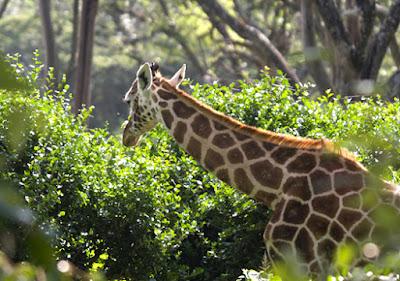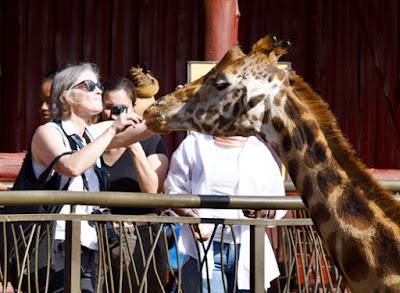
Reticulated giraffe feeding on bushes at the Giraffe Center, Nairobi, Kenya.
With many thanks to Humberto Gutierrez Rivas for his report and terrific photos of his family's trip to Kenya last January. His post about their wildlife experiences near Nairobi is in three parts, the first appearing two weeks ago, Part 3 today, and Part 2 last week.
This past January our family had the trip of a lifetime to Kenya for 12 days to visit friends in Nairobi, go on safari, and visit the island of Lamu. There were many highlights of this trip, and one that got it started happened right there in the city of Nairobi.
Less than 8 hours after our arrival, we were met at the front door of our friends’ house by Amos, our guide, and his safari van. Our friends had coordinated a day expedition for us to Nairobi’s National Park, the Sheldrick Elephant Orphanage center, and Giraffe Center.
Amos drove us from the north to the south part of the city to get us to the park, so we also got to see the early morning activities of people walking to bus stops, walking to work, and opening shops along the road.
Giraffe Center

Petting and feeding food pellets to a Rothschild giraffe.
Our last stop for the first day, after visiting the Sheldrick Elephant Orphanage and Nairobi National Park, was the Giraffe Center. Although the Giraffe Center is not located right at the national park, as is the elephant orphanage center, it is near it. It’s a very popular place to visit. To enter the center you go through some stations where you are asked to wash your shoes and your hands because you will be in very close contact with the giraffes when you feed them. The center has a tall walkway that curves around the main building.

Petting a giraffe.
All visitors get a handful of giraffe food in the form of pellets in a half coconut shell. Some giraffes come to the walkway to meet the visitor and get easy food--others feed on leaves in the nearby trees. There are signs that warn you to be careful so that the giraffe doesn’t bump you with its head.

Masai giraffe.
We learned from other signs that in the area we are likely to see three species of giraffes. We can tell them apart by the skin pattern: the Reticulated (tile like marks), the Masai (maple leaf like marks), and the Rothschild (darker patches with white spaces between patches). My wife and daughter stopped to feed the giraffes. You put some small amount of pellets in your fingers and drop it into the giraffe’s tongue, but if you are not careful, a long tongue goes for the coconut shell instead of your hand. Giraffes have a grayish and slimy tongue.

Warthogs and giraffe. A warthog family feeding from fallen pellets.
We also saw a family of adult and young warthogs resting and running between the legs of the giraffes to feed on pellets that fall to the ground. We spent close to an hour at the center, and at 5:30 in the afternoon we were ready to go back to our friend's house. The next day would start very early with a six hour drive for a three day visit to the Masai Mara National Park
